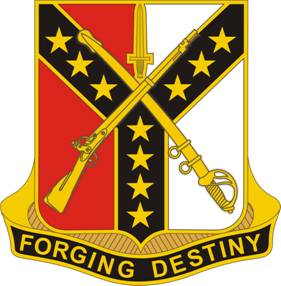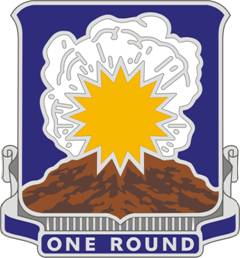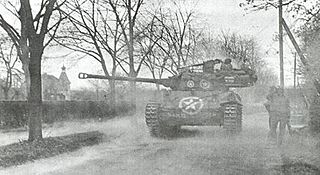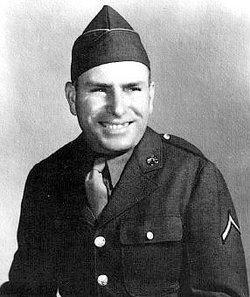
The 92nd Infantry Division was an African-American infantry division of the United States Army that served in both World War I and World War II. The military was then segregated. The division was organized in October 1917, after the U.S. entry into World War I, at Camp Funston, Kansas, with African-American soldiers from all states. In 1918, before leaving for France, the American buffalo was selected as the divisional insignia due to the "Buffalo Soldiers" nickname, given to African-American cavalrymen in the 19th century. The divisional nickname, "Buffalo Soldiers Division", was inherited from the 366th Infantry, one of the first units organized in the division.

The 601st Tank Destroyer Battalion was a battalion of the United States Army active during World War II. It was the first of the newly formed tank destroyer battalions to see combat, and the only one to fight as a "pure" tank destroyer force. It also has the unusual distinction of being one of the few American units to fight in all three major campaigns against Nazi Germany and to have participated in four assault landings.

The 603rd Tank Destroyer Battalion was a tank destroyer battalion of the United States Army active during World War II.
The 605th Tank Destroyer Battalion was a tank destroyer battalion of the United States Army active during World War II.
The 607th Tank Destroyer Battalion was a tank destroyer battalion of the United States Army active during the Second World War. They arrived in England during April, 1944, and entered combat in mid June, landing at Utah Beach. The unit fought across France and into Germany during the summer and early winter of 1944. In late winter, they were then pulled out and sent to Belgium near the end of the Ardennes Campaign and again fought their way into and across Germany, ending the war near the Czechoslovakian border. The 607th received credit for the Normandy, Northern France, Rhineland, Ardennes-Alsace and Central Europe campaigns.

The 818th Tank Destroyer Battalion was a tank destroyer battalion of the United States Army active during World War II. It first saw combat in July 1944, when it deployed into the Normandy beachhead in preparation for the breakout into France by Lieutenant General George Patton's Third Army. Working closely with the 5th Infantry Division, it moved through northern France up to the Moselle region, where it was involved in the Battle for Metz through September, October and November. In December, it disengaged from defensive positions along the German border and was moved north to fight in the Battle of the Bulge with the 26th Infantry Division. After securing the Allied flanks and mopping up the Bulge, it refitted for two months before fighting south along the Siegfried Line and crossing the Rhine in March. In April and early May, it rushed through southern Germany into Austria and Czechoslovakia, where it ended the war. After a brief spell of occupation duties, it was returned to the United States and disbanded in November. During the European campaign, the battalion lost a total twenty-six men and eight tank destroyers in combat.

The 809th Tank Destroyer Battalion was a tank destroyer battalion of the United States Army active during the Second World War.
The 773rd Tank Destroyer Battalion was a tank destroyer battalion of the United States Army active during the Second World War.
The 628th Tank Destroyer Battalion was a tank destroyer battalion of the United States Army active during the Second World War. It was redesignated the 628th Tank Battalion after the end of the war, and today exists as the 103rd Armor Regiment.

The 805th Tank Destroyer Battalion was a tank destroyer battalion of the United States Army active during the Second World War.

The 808th Tank Destroyer Battalion was a tank destroyer battalion of the United States Army active during the Second World War.

The 643rd Tank Destroyer Battalion was a tank destroyer battalion of the United States Army active during the Second World War.
The 631st Tank Destroyer Battalion was a tank destroyer battalion of the United States Army active during the Second World War.

The 633rd Tank Destroyer Battalion was a self-propelled tank destroyer battalion of the United States Army active during the Second World War.

The 705th Tank Destroyer Battalion was a tank destroyer battalion of the United States Army active during the Second World War. It was originally formed from artillery elements of the 5th Armored Division, and its lineage is today perpetuated by the 75th Cavalry Regiment.
The 825th Tank Destroyer Battalion was a tank destroyer battalion of the United States Army active during the Second World War. It was organized as a towed battalion, with 3" anti-tank guns, and initially saw service during the Battle of Normandy as a rear-area security unit. Parts of the unit were sent into combat as part of an ad hoc task force on 16 December 1944, on the northern flank of the Ardennes Offensive, where it defended Amblève river bridges at Malmedy and Stavelot. It returned to security duties at the end of January 1945, and served in rear areas for the remainder of the war.

The 648th Tank Destroyer Battalion was a tank destroyer battalion of the United States Army active during the Second World War.

The 824th Tank Destroyer Battalion was a tank destroyer battalion of the United States Army active during the Second World War. It saw service during 1944–45 in the European Theater of Operations, primarily attached to the 100th Infantry Division in an infantry support role. After fighting through France and southern Germany, the battalion ended the war in Austria.

Private First Class Charles Havlat is recognized as being the last United States Army soldier to be killed in combat in the European Theater of Operations during World War II. On May 7, 1945, he was a member of a reconnaissance patrol of the 803rd Tank Destroyer Battalion operating near Volary, Czechoslovakia. The patrol was ambushed by German soldiers, and Havlat was struck and killed by small arms fire about ten minutes before the news that all German troops in Europe were to obey a ceasefire order reached his unit, and only about six hours before the unconditional surrender of Germany.
The 679th Tank Destroyer Battalion was a tank destroyer battalion of the United States Army active during the Second World War. The unit was activated in June 1943 and shipped overseas in January 1945. After arrival in France, the unit was sent to the Mediterranean front. After arrival, the unit was attached to the 92nd Infantry Division. Like the 614th Tank Destroyer Battalion, it was one of the three segregated tank destroyer battalions that participated in combat during the Second World War.









